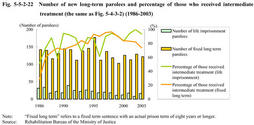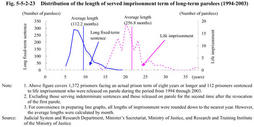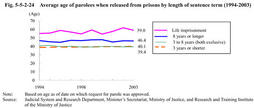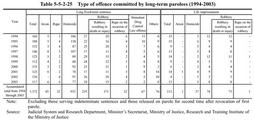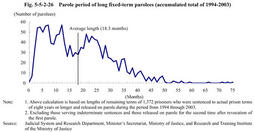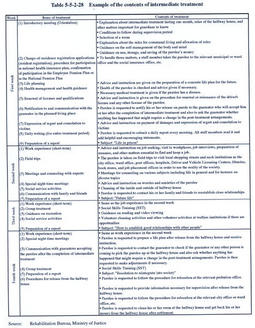| Previous Next Index Image Index Year Selection | |
|
|
4. Long-termParolees Parolees who have been imprisoned for a long time have to overcome particular problems to reintegrate themselves into society successfully.For this reason,special measures have been taken since1979to enhance the examination system to grant parole to those prisoners with life imprisonment or an actual imprisonment term of eight years or longer.Furthermore,they are required to receive intermediate treatment after parole release,which is a program to have them stay in halfway houses and receive intensive treatment to facilitate their social adjustment before their returning to their final living places(see this part,Chapter4,Section3,2 ).This section will describe the characteristics and treatment of long-term parolees.
(1) Number of long-term parolees and percentage of those received intermediate treatment Fig. 5-5-2-22 shows the number of new long term parolees and percentage of those received intermediate treatment since1986,when long term prisoners in all prisons came to be subject to intermediate treatment.
The number of life parolees has declined from a long-term standpoint(see Fig. 5-4-2-9 )to16in2003.The number of long fixed-term parolees fluctuated from100to180each year,standing at122in2003.The recent10-year average percentage of those who received intermediate treatment is87.6%of life parolees and87.0%of long fixed-term parolees,indicating that most new long-term parolees have received intermediate treatment. Fig. 5-5-2-22 Number of new long-term parolees and percentage of those who received intermediate treatment(the same as Fig. 5-4-3-2)(1986-2003) (2) Served imprisonment term Fig. 5-5-2-23 shows the distribution of length of served imprisonment term and its average length of long-term parolees before their parole release in the past10years.They consisted of1,372long fixed-term parolees and112life parolees,excluding those serving indeterminate sentences and those released on parole for the second time after the revocation of the first parole.The length of served imprisonment term of long fixed-term parolees ranged from five years to19years and two months,averaging at112.2months.The served term of life parolees ranged from13years and three months to38years and10months,standing at256.8months on average.
Fig. 5-5-2-23 Distribution of the length of served imprisonment term of long-term parolees(1994-2003) (3) Age Fig. 5-5-2-24 shows average age of a total of137,300parolees when their parole applications were received,for the recent10years,by the terms of their sentences.On average,parolees serving long fixed-term sentences were older than those serving shorter sentences,and those serving life imprisonment were the oldest.
The10-year average age of those parolees with three year or shorter sentences and that of those with more than three years but less than eight years sentences are almost the same,at39.4yeas old and39.8respectively.The average age of those parolees with eight years or longer sentences is46.3,while that of those with life imprisonment is56.8(Source:Judicial System and Research Department,Minister's Secretariat,Ministry of Justice,and Research and Training Institute of the Ministry of Justice).The old ages of long term parolees reflect that long-term prisoners,especially life imprisonment prisoners,have spent a long time in prisons before parole. Fig. 5-5-2-24 Average age of parolees when released from prisons by length of sentence term(1994-2003) (4) Type of offense Table 5-5-2-25 shows the types of offenses committed by long-term parolees released in the past ten years,excluding those serving indeterminate sentences and those released on parole for the second time after revocation of their first parole.Homicide accounted for almost70%long fixed-term parolees,followed by robbery often resulting in death or injury."Others"include theft,Firearms and Swords Control Law violations,and Narcotics Control Law violations.In the case of life parolees,robbery resulting in death or injury had the largest share,followed by homicide.
Table 5-5-2-25 Type of offence committed by long-term parolees(1994-2003) (5) Parole period Fig. 5-5-2-26 shows the distribution of length of parole periods and its average length of a total of1,372long fixed-term parolees who were released over the past ten years(excluding those serving indeterminate sentences and those paroled after the revocation of their first parole).
Their average parole period is18.3months,one year longer than the average4.8months of all the135,283fixed-term parolees.Their parole period ranged from less than one month to75months,indicating that there is a wide variety among parolees,some are released on parole long before the completion of their terms and others are released just before the completion of their terms. Fig. 5-5-2-26 Parole period of long fixed-term parolees(accumulated total of1994-2003) (6) Amnesty for life parolees A parolee serving life imprisonment sentence is placed under supervision for a lifetime unless he/she receives an amnesty(general amnesty,special amnesty,commutation of sentence,or remission of execution of sentence). Fig. 5-5-2-27 shows the number of life parolees who received amnesty(remission of execution of sentence)in the past20years.
Fig. 5-5-2-27 Number of life parolees who received amnesty(remission of execution of sentence)(1984-2003) (7) Treatment for long-term parolees As detailed above,most parolees serving long-term sentences have committed serious offenses such as homicide and robbery resulting in death or injury and therefore tend to be criticized by the society.In addition,they have such problems as(1)it takes a long time for them to adapt to a normal life and live an independent life mostly because many of them have poor abilities,(2)they tend to handle small daily problems inappropriately due to the lack of ordinary social experiences and end up causing trouble,(3)they are estranged from their family members after losing close family members to death or failing to establish good relationships with them and live lonely lives as a result,and(4)they,life parolees in particular,tend to have problems with health and employment due to their old age.
It is,therefore,necessary to take special treatment measures exercising parole supervision for parolees serving long-term sentences.For this reason,an intermediate treatment program has been implemented since1979to promote their smooth reintegration into society and to identify their rehabilitation problems to make parole supervision more effective. Under the intermediate treatment program,a parolee must temporarily stay in a halfway house after being released on parole and receive intensive treatment designed mostly to facilitate their early social adjustment.It is implemented only for those selected by Regional Parole Boards if they agree.The program is for one month,during which a parolee is required by a special parole condition to stay in a certain halfway house to receive treatment. Intermediate treatment program provides many kinds of support including(1)advice on the official procedures of residential relocation,driver's license,and social insurance,(2)advice and instruction on their jobs,financial balance between income and spending,and other matters essential to build a stable life,(3)social skills training(SST:See column on page385)and counseling service,and(4)meetings and communications with their relatives,employers,and other relevant people and other preparations for their life after finishing intermediate treatment.Intermediate treatment is implemented by probation officers at probation offices and staff members of halfway houses. Table 5-5-2-28 shows an example of an intermediate treatment program in a halfway house.A parolee,after completing the program,moves to his/her family or relatives and then is supervised by a probation officer and volunteer probation officer in charge of the location of his/her living place. To further enhance parole supervision for a parolee serving a long-term sentence,the Rehabilitation Bureau of the Ministry of Justice revised the treatment guideline in2000.It decided to appoint more than one probation officer per a parolee,if necessary,and also to have the probation officer meet such a parolee more often especially during the one-year period after release from a prison.The issue of consolation to victims has been incorporated into the revised treatment guidelines.The revised guidelines require the probation officer in charge of him/her to make efforts to keep informed about how the victims are and how they feel about the parolee.The probation officer is also required to awaken the parolee's willingness to express his/her regret and pay damages to the victims and to give him/her guidance and advice on what he/she should do.Since the victims cannot have their damage restored even if the parolee starts leading a respectable and stable life,their treatment now t akes into consideration the consolation of crime victims. Table 5-5-2-28 Example of the contents of intermediate treatment |
